Why Are My Honey Bees On The Ground?
Walking out to the bee yard and seeing a clump of honey bees on the ground is never a good feeling. We beekeepers do our best to do a good job with our hives. But, we sometimes make mistakes-as I soon realized one day in my bee yard. When we notice a bee behavior we do not understand – it is common to consider if our actions caused the behavior.
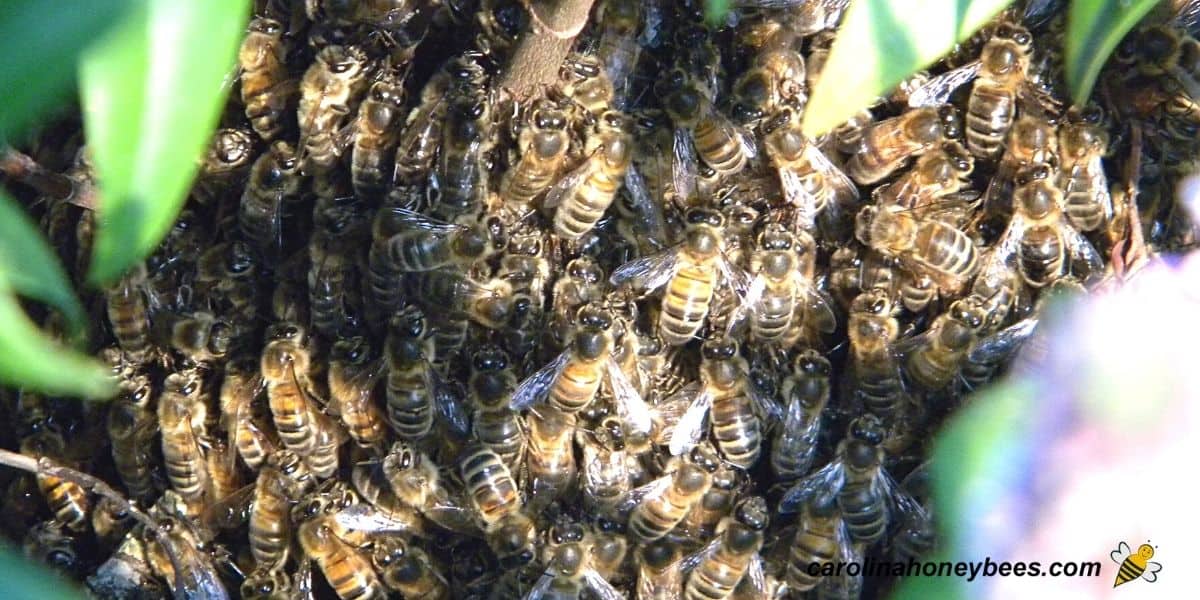
Sometimes is it our actions that cause a reaction by the colony. You see that something different is happening to your colony but it seems weird. An important part of hive management is trying to figure out what is happening and why!
Finding Honey Bees on the Ground
We expect to find them in our honey bees garden, visiting flowers and buzzing here and there. However, there are some times when you may find some on the ground – perhaps in the grass. It may be a large mass of bees or perhaps only a handful.
Whether or not this is an issue to be concerned about depends on several factors – including how many bees are down there. Still, any time we find a lot of bees in an unusual state, it is clear that something is happening.
There are several reasons you may see a few worker bees at ground level. Perhaps they are drinking water from damp soil, mine love to drink nasty donkey poop water – even though the bees have a clean water source.
Or maybe they have found a sweet food source that is not apparent to our eyes. Worker bees collecting all resources needed by a colony.
Sometimes they are access nutrients that we can’t see. In either case, finding a mass of bees on the ground is cause for further investigation.
Do Honey Bees Live in the Ground?
A beehive is usually found in an enclosed cavity – either a hollow tree or a man-made hive. In general, you will not find honey bees living in the ground.
Many folks are not familiar with what a honey bees looks like – at least while in flight.
In most cases, the striped insects we see coming and going from a hole in the ground are not really bees. They end up being wasps.
In my area, Yellow Jacket Wasps live in the ground in large colonies and are certainly not honey bees. While both wasps and honey bees are insects, you will not find any honey inside this type of nest.
Wasps serve a good purpose in controlling pest insects. But, they cause problems when they nest near playgrounds or areas with foot traffic.
Beekeepers often set up DIY Yellow jacket wasp traps to try to reduce the number of wasps near the bee yards.
Only once, have I found an actual beehive with honey bees that seemed to be living in the ground. On closer inspection, they were actually nesting in the remains of a dead tree stump. Could they not find a better place?
Other course that are other types of bee and wasp nests found in the soil. However, these insects do not live in large families.
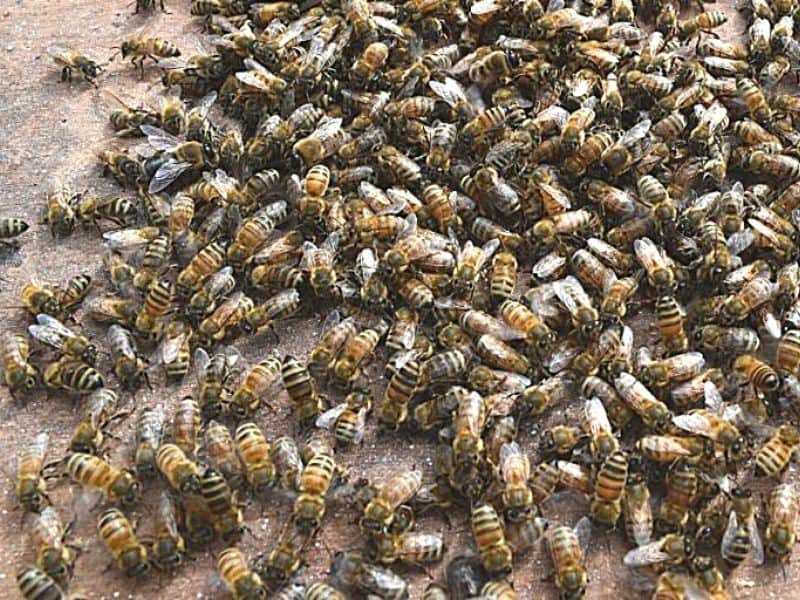
Honey Bee Behavior
In spite of many years of study, we still don’t understand everything that our colonies do. Honey bee behavior is a complex thing.
A perfect example is festooning bees – (a behavior that occurs inside the hive). We know it happens but still don’t know exactly why!
While a hive of bees living in the ground is not likely – never say never. Sometimes, we beekeepers do things that cause a reaction by the colony.
One example is a new beekeeper that places a colony inside a freshly painted beehive. Sometimes, this may cause the bees to abscond or just leave.
The bee antenna is similar to our nose – it contains sensitive odor receptors. Don’t do anything that could cause a your bees to look for better accommodations.
Using visual cues and special bee pheromones, the needs of the hive are communicated to the other members. We must strive to avoid doing things that upset this balance.
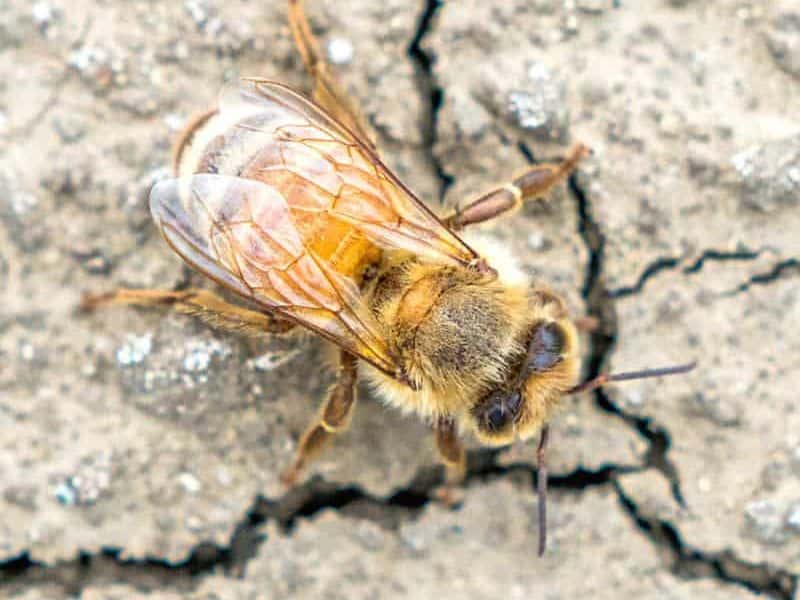
Bees in Front of Hive: Normal or Not?
Every hive inspection should begin at the front door of the beehive. You can not understand everything about colony status from entrance observation. But, always take a quick peek before opening the hive.
Dead Bees on Ground
Anytime you go to your apiary – you may see some dead bees laying in front of the hive. Don’t panic. Some of them die every day because they have reached the end of the normal honey bee life cycle.
Inside the hive, some workers have undertaker duty. They grab the dead bodies and fly away with them or simply throw them out the front. Don’t despair if you see a few dead colony members.
Crawling Honey Bees
What about live honey bees crawling near the hive? This is not a big problem as long as it’s only a few. Finding 15 or 20 bees on the ground unable to fly could signal a pest or disease problem.
Also called, “crawlers”, bees unable to fly could be suffering from issues related to infestations (perhaps varroa mite treatments that didn’t work) or even pesticide exposure.
This could be a minor problem that does not require action but you should take a minute to recheck your last mite counts or tests or treatments.
Handfuls of Dead Bees
If your girls have been exposed to a deadly pesticide, it is common to find handfuls of dead in front of the hive – a very sad situation indeed. There will be hundreds or thousands of dead and dying bees out front.
Often, there is not much we can do about this as we have no idea where the foragers were poisoned.
Hopefully, you will only lose the field force and they did not bring poison pollen back to the hive. When poison gets into the bee bread or stored pollen – this represents a greater threat.
Mosquito spraying can harm beehives, as well as, agriculture pesticides. If the colony retains enough workers, they have a chance to rebuild.
Bee Bearding at Hive Entrance
One situation that often strikes fear in new beekeepers is seeing masses of bees hanging off the front of the hive. Are the bees leaving or running away? This can happen if the colony is starting to cast a bee swarm.
However, usually this is a phenomenon called bee bearding. The girls are simply sitting outside on the front porch during a hot humid evening.
While not a sign of an imminent swarming, strong colonies are more crowded and more likely to form a beard. They are also most likely to swarm so routine inspections are a great idea when you see a lot of beards.
Be Observant In The Bee Yard
It is a good idea to walk through your bee yard occasionally and just observe. You don’t always have to open your hive to gain some understanding on your colony status.
Look carefully (but not too closely without protective bee clothing) at the entrance and the area in front of the hive.
Look for any evidence of fighting at the hive entrances. Fighting or wrestling at the front can be a sign of honey bee robbing.
Always watch for anything unusual (zombie bee behavior?) and make notes in your beekeeping journal in case you need to recall the event later. Your colony could be reacting to many different things.
If You Find a Swarm of Bees on the Ground
Okay, this is for you non-beekeepers, who may have ended up here looking for help. For my beekeeping friends, if they tell me they see a small swarm of bees on the ground – I say catch it!
For everyone else, I have some suggestions and a few cautions.
- confirm that they are honey bees (if you can)
- do a google search for a local beekeeping associations
- call your local agricultural extension agency for advise
- keep kids and pets away
First, are you sure these are honey bees and not nesting yellow jackets? If they are honey bees, this could be a very small swarm (even with a queen in there) that for some reason is not moving to a new home.
It is possible that they may leave in a day or so – but they could be having a problem. Unless you live in areas with Africanized Bees – killer bees, honey bee swarms are not dangerous .
Leave them alone, they can and will sting. But honey bee sting if they feel threatened. Give them some space – keep children and pets away. Sometimes dogs bite at bees – not a good situation.
Reach out to a local beekeeper or ag agency for help relocating the bees if they do not leave in a couple of days.
Unexpected Bee Behavior in My Bee Yard (Personal Goof)
During a recent walk through the apiary a few years ago. Something caught my eye. I found a small clump of bees on the ground near a hive. How odd.
It is not rare to find a small honey bee swarm on the ground – though you will usually see a swarm hanging in a nearby tree or bush. Yet, if a queen bee sits down – the rest of the swarm will as well.
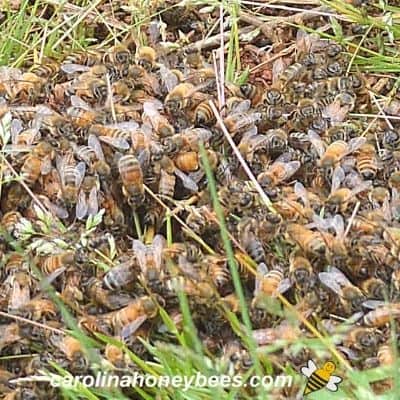
My curiosity is peeked. They do not appear to be sick – the mass looks very small to be a swarm? Why is this happening? Have I done anything to cause this?
Yes, maybe I did. A quick peak in my beekeeping journal tells me that this was one of the hives I inspected yesterday. What did I do?
Failing to Find a Queen
This was one of the colonies that I found to be low in population during some hive inspections this week. If fact, I had found a colony with problems yesterday.
I thought one of the colonies was without a queen or had a drone layer and the other colony had a small population.
I used my normal method of combing beehives with newspaper. This method works for me, 99% of the time. One fact about the queen, the new colony doesn’t always accept her readily.
Did I make a big beekeeping mistake? It was time to take a closer look. Using a small stick, I gently move the mass around and see an unmarked queen! Good gravy what a mess!
Putting 2 Queens in 1 Hive – OOPS
My goodness, there must have been a queen in both hives after all. Well, this is a fine mess I have made.
Usually, if you combine 2 small hives that both have queens, 1 queen will be killed and the population will merge.
My guess is that instead of killing the other queen. One queen and her group of worker bees forced this lady out of the hive. The result was a clump of honey bees on the ground with their queen.
This shows that anytime you do anything with bees, there is a possibility of failure. I had searched through both hives several times.
I did not see any indication of a queen being present in the other hive. But I obviously goofed ! And even with experience, you cant always find the queen bee.
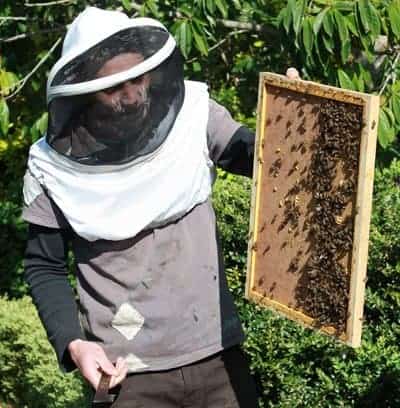
Fixing My Beekeeper Mistake
Now what to do? Both of the colonies were rather small. A weak hive – only a handful of bees, stands little chance anyway and could certainly not protect a full sized box.
They really don’t have enough population for a even 5 frame nuc sized box. The number of workers with this queen may not be enough to sustain her and I do not have any spare workers to add to them.
However, it is always a good thing to have an extra queen around-maybe I can save her for a while.
Using a Mini Mating Nuc
I caused this issue for my colony and I feel a responsibility. So, I will do something… I must try. I have a small queen mating nuc box that would be just the right size. These mini boxes are used to house new virgin queens while they mate and begin to lay eggs.
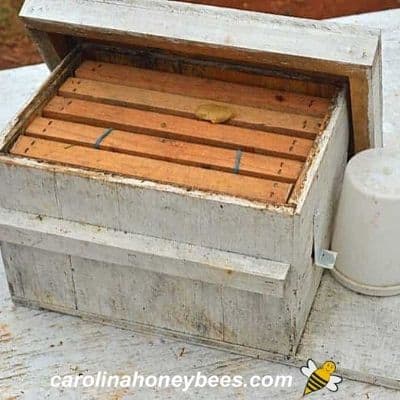
Their small size means they can only be used for a short time. But they are great when only a week or two of space is needed.
I take one of the empty mini frames – none of them have drawn comb. In my equipment area, I find a frame with comb that was damaged by a rat (who ate half of it 🙁 .)
This scrap piece of comb is placed into one of the mini frames using rubber bands (make sure the cells are not upside down), now the queen and bees have a place to start.

Sugar water is sprayed on comb in the mini frame. I lay it down beside the pile of honey bees on the ground and they started to climb aboard. I picked up the queen and placed her on the comb.
Now this frame is placed inside the mini hive. The remaining workers smell the queen and their sisters inside the box. In a short time, all of the bees are inside.
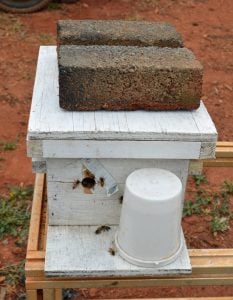
This post may contain affiliate links. As an Amazon Associate, I earn from qualifying purchases. Please read my disclosure.
Of course, you can buy commercial versions. Too small for much but they come in handy sometimes.
Queen Bee Mating Hive Mini Nuc
A Final Word
It is rather unnatural to find honey bees on the ground. Unless it is something that involves queen issues or swarming, your first thought should go towards a pest or bee disease problem. However, you may make a dumb mistake – like me. Always strive to understand the reasons behind unusual bee behavior. It is actually a lot of fun. And, if you find other types of bees in the ground – it is interesting to try to identify them and decide if you need to take action or just let them – bee.


